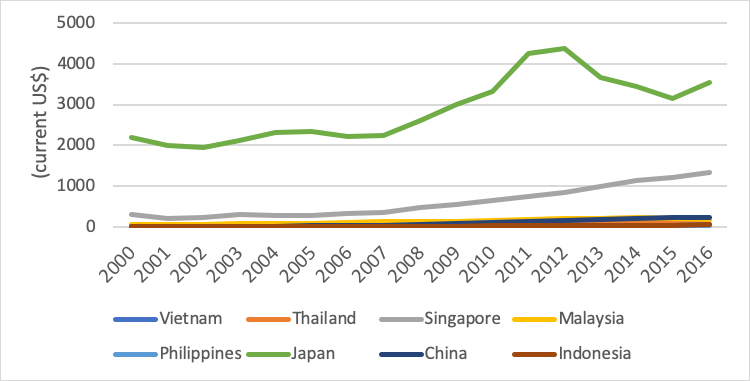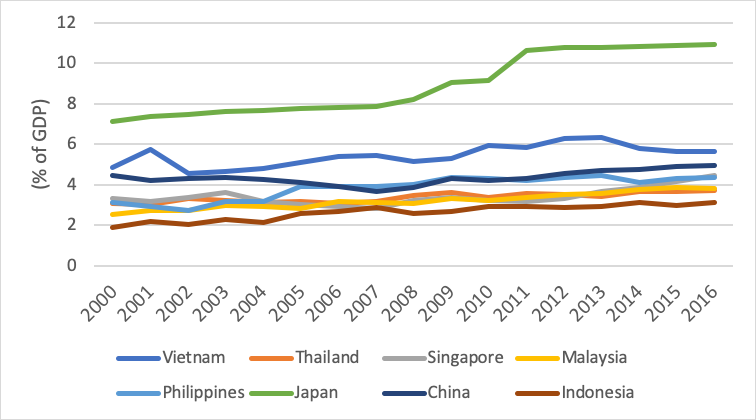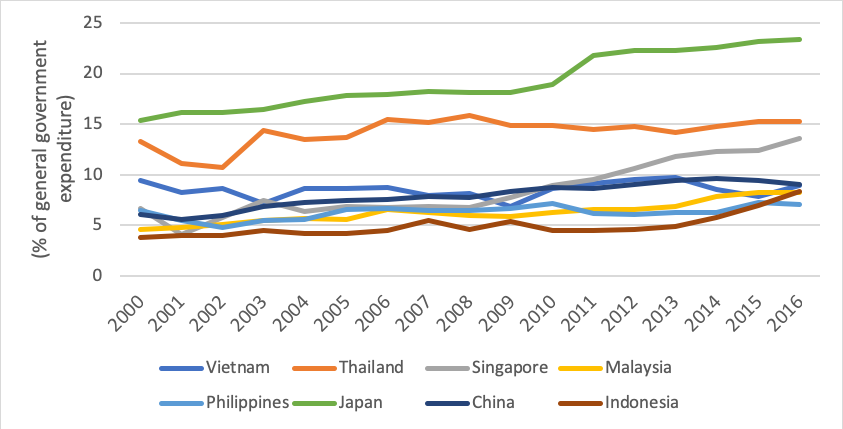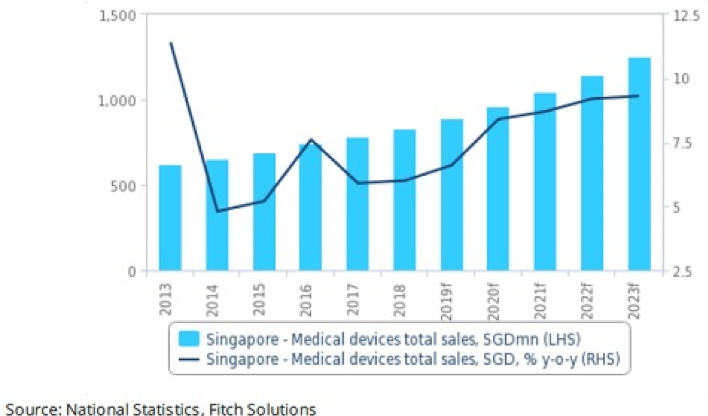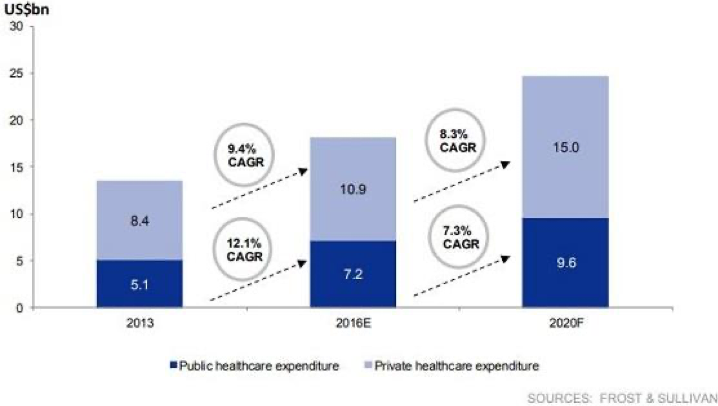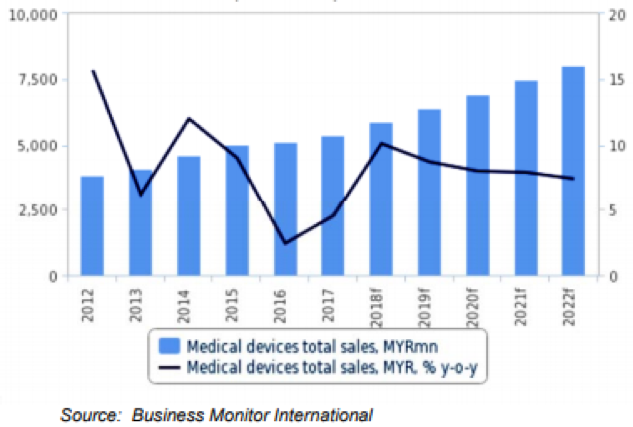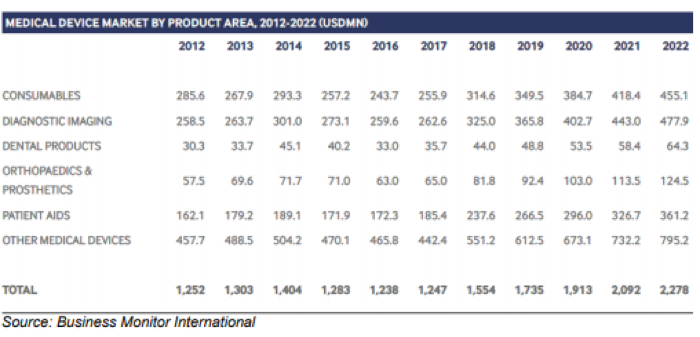|
Outline: - China Highlights “Internet Plus Healthcare” - Singapore: A Modern and Progressive Gateway to Asia - Malaysia set to Become Major Healthcare Hub in Asia - Thailand Sees Significant Growth in Private Sector by Medical Tourism
In the journey towards realizing the ambitious goal of universal health coverage, more countries are expanding benefits, creating institutional arrangements and allocating public funds to expand health services coverage. Countries from all regions and at all levels of income are increasingly spending more to cater to growing public demands. In 2016, the world spent US$ 7.5 trillion on health, representing close to 10% of global GDP. Health spending is growing faster than the overall economy globally as well as in most countries. In this article, we are looking at the healthcare expenditure and medical device demand trends in China, Thailand, Malaysia and Singapore, to understand how their government are spending to improve the living standard of their citizens.
China Highlights “Internet Plus Healthcare” Chinese government’s share in healthcare expenditure has been rapidly increasing. In 2000, its domestic general government health expenditure per capita was US$ 9.3 and it has increased up to US$ 231 in 2016. As its GDP grows, its public budget is expected to grow faster. However, the share of healthcare expenditure spent in China is much lower than other countries in Asia such as Singapore and Japan. In 2016, China spent only 9% of its expenditure on healthcare, whereas Singapore spend 13% of its expenditure. Under such publicly spent less budget, hospitals in China are overcrowded due to the unequally distributed healthcare and rapidly growing demand of middle class for healthcare. To tackle these issues, the government announced in the 13th Five-Year Plan and the Healthy China 2030 strategy that healthcare is now an important area to improve. in the 13th Five-Year Plan and the Healthy China 2030 strategy. The government particularly issued guidelines to promote internet-based healthcare to increase the accessibility and efficiency of healthcare. The leading private company, Tencent, has already built up a system which collaborates with more than 38,000 medical facilities since 2017. Tencent’s system enables people to book doctor’s appointments, access their medical reports and pay for their medical bills through WeChat so that the users can avoid overcrowded hospitals. In order to even out both the medical resource and the demand of patients, online medical consultation, remote patient monitoring and online clinician support are already becoming a standard. The world’s leading healthcare ecosystem platform, Ping An Good Doctor, has created cooperation with nearly 50 hospitals across China, to provide comprehensive medical management platform, featuring online diagnosis platform, prescription sharing platform and health management platform. This “online hospital” system not only benefits to an increase of accessibility but also to the integration of healthcare data. There seems tons of rooms for foreign manufacturers to cultivate the market of China, yet foreign manufacturers must pay attention to its domestic manufacturing plan. According to China’s “made in China 2025” initiative, China is aiming to strengthen the use of its domestic products in hospitals to 70 per cent by 2025, Chinese government plans to strongly support and upgrade its domestic products so that they can prevail in the export market. Leading Chinese companies such as Alibaba and Tencent have been making significant progress in healthcare field and looked at ways to build diagnostic tools to make doctors more efficient.
Source: World Bank, 2020 Figure 1: Domestic general government health expenditure per capita (current US$)
Source: World Bank, 2020 Figure 2: Current health expenditure (% of GDP)
Source; World Bank, 2020 Figure 3: Domestic general government health expenditure (% of general government expenditure) References: 1) China’s new industrial policy dismissed as ‘Made in China 2025’ rehash by critics in Washington 2) The Chinese Health Care System 3) Made in China 2025 to intensify medical market competition according to GlobalData 4) China's healthcare sector promising for 2020 and beyond 5) Ping An Good Doctor to develop 'internet hospital' model with 50 hospitals in China
Singapore: A Modern and Progressive Gateway to Asia When it comes to medical device market giants in the SEA or even the ASEAN region, no place can match Singapore’s combination of technology leadership, its proximity to Asian markets, and its pioneering medical infrastructure. It has constantly been in the news for ranking one of the world bests in providing best healthcare landscape and infrastructure in the region. Singapore spends 4.6% of its annual GDP on healthcare and provides universal coverage for Singaporeans with multiple layers of care. In response to the growing healthcare needs brought about by a rapidly ageing population in 2019, their government has also set aside a US$6.1b fund that will subsidise healthcare for Singaporeans born in the 1950s. Answering to this increasing demand, in 2018, imports of medical equipment and supplies to Singapore increased by 8% over the previous year. This corresponds with the increased spending associated with the establishment of new hospitals and healthcare facilities. U.S. medical equipment and supplies accounted for 30% of market share in 2018 and this has stayed consistent over the last few years.
Figure 4: Singapore Medical Device Market, 2013-2023, Local Currency
This chart from Fitch Solutions shows that Singapore’s medical device market value could reach SING$1.3b by 2023, with a 2018-2023 compound annual growth rate (CAGR) of 8.4%. Increased government expenditure on the growing healthcare needs of the ageing population is expected to boost the medical devices space. As described above, its drivers include a rapidly ageing population with a growing disease burden, high quality healthcare provision financed by a combination of private saving schemes and government subsidies. Over a quarter of the population will be 65 years and older by 2030. As such, more facilities for the elderly, such as nursing homes and rehabilitation centres, need to be built. The demand for services such as geriatric medicine and rehabilitation medicine are expected to rise as is demand for homecare services.
Figure 5: Total healthcare expenditure in Singapore is forecasted to reach US$24.6bn by 2020F Overall, a separate report from Frost & Sullivan stated total healthcare expenditure in Singapore is tipped to hit SING$33.6b (US$24.6b) by 2020. Private expenditure will account for $20.5b (US$15b) whilst public healthcare expenditure may reach $13.1b (US$9.6b). Foreign firms specializing in products and services, catering to an increasingly tech-savvy ageing population especially, will find a robust and growing market in Singapore. Reference: 1) Growth in Singapore medical device market cut to 8.4% for 2018-2023: Report 2) Singapore Medical Devices Market 2012-2017 & 2018-2022 3) Singapore dazzles as a world leader in medical manufacturing 4) Singapore's medical device market value to hit $1.3b by 2023 5) Here's why Singapore's healthtech landscape looks promising 6) SGH ranked world's third best hospital by Newsweek
Malaysia set to Become Major Healthcare Hub in Asia Being one of the fastest growing major healthcare hubs in the ASEAN region, Malaysian government has always placed huge emphasis on access to quality healthcare and social welfare protection. In ensuring welfare and quality of life, the new government is committed on improving healthcare provision, having allocated a sum of RM29 billion (US$7 billion) for the public healthcare sector for 2019, almost 10% of the total national budget. Out of that sum, RM10.8 billion (US$2.6 billion) is set aside for development, maintenance and upgrading work of existing public healthcare facilities and the procurement of new medical equipment. The market will also benefit from the government plans to boost the healthcare tourism industry through specific funding for the Malaysia Healthcare Travel Council (MHTC) to promote the country as a hub for fertility and cardiology treatments. These clearly pave the way for foreign medical device manufacturers to establish their strong presence in the local market.
Figure 6: Medical Device Market Value (RM) (2012-2022) RM100 million (US$24 million) has been set aside for the 2019 National Health Protection Scheme (PEKA), which is a targeted health protection fund for the base 40% (B-40) of the Malaysian population. In addition to this, the government is also constantly subsidizing various healthcare screenings and procurements, creating more opportunities for foreign medical device manufacturers to cater to a growing demand for state-of-the-art equipment.
Figure 7: Medical Device Market by Product Area in Malaysia, 2012-2022 Projections (USD$ million) Malaysia’s medical device market demand has been encouraging, especially in the last few years, along with the governments’ push to make it a key economic driver, as seen in Figure 4 above. In 2018, the total trade for Malaysia’s medical device industry was USD$2.47 billion and it imported over USD$7250 million of medical devices. Overall, Malaysian imports of medical devices increased 25% over 2018/2017 period. The type of medical devices Malaysia imports and exports differ significantly. Malaysia usually imports higher classification or category of medical devices, which not manufactured locally. It is to be noted here, just as an ageing population is proving to be an issue in Singapore, the alarming increase in non-communicable diseases in Malaysia serves to worry the local government. According to the 2015 National Health and Morbidity Survey (NHMS), about two-thirds of Malaysians have at least one of three non-communicable diseases (NCDs), i.e. diabetes, high blood pressure (hypertension) or high cholesterol levels (hypercholesterolaemia). More than one in four (26.3%) have at least two of these NCDs and 7.2% have all three NCDs. According to the 2018 Medical Trends Around the World report, Malaysia’s medical trend rate is expected to hit higher than 12.5% in 2019, following an increase in the reported cases of NCDs. This will result in higher demand for NCD related monitoring, treatment and various prostheses or rehabilitation devices. Due to the rising healthcare expenses, more citizens are turning to the solutions offered by public-funded healthcare institutions, resulting in more government expenditure in these medical sectors. Apart from this, Malaysia is also seeing aesthetic procedures increasingly being offered in private healthcare facilities. This includes areas of orthodontics, implant and aesthetic procedures, topping the dental market trends in Malaysia, while The United States is one of the leading suppliers of orthodontics products in Malaysia. Tapping into these subsectors will also help foreign manufacturers to make their way into this lucrative and dynamic medical device market. Reference: 1) The Star Online: An outlook on the Malaysian healthcare scene for 2019 2) The Star Online: Malaysia's healthcare market to reach RM127.9b by 2027, says Fitch Research 3) Malaysia National Health Accounts Health Expenditure Report 1997-2016 4) Malaysia Health System Review 5) Medical Device Market in Malaysia (July 2018) 6) The plague of NCDs afflicting Malaysia
Thailand Sees Significant Growth in Private Sector by Medical Tourism Since the introduction of universal health coverage (UHC) in 2002, all Thai citizens are now able to access healthcare services. As Thai citizens enjoy their entitlement to their healthcare, Thailand’s healthcare expenditure is steadily increasing for the past two decades. Its domestic general government health expenditure per capita in 2000 was US$ 26 and in 2016 it marks US$ 173, which takes up 3.7% of Thailand’s GDP. Despite the benefit of the healthcare system, the UHC policy faces several challenges. The cost of the policy is one of the highest among low-and middle-income countries, where Thai government spends 15.2 % of its general government expenditure on healthcare. Secondly, rising health-care costs is also a major issue due to increasing healthcare needs alongside the increasing cost of technological advances. Thirdly, the prevalence of preventable and controllable infectious and non-infectious illnesses shows an upward trend, which indicates its government revenue is not efficiently spent. Thailand’s promotion of medical tourism takes a large part of such heavily spent healthcare expenditure. Thai government is aiming to become a global center for medical tourism by executing several strategies such as tax exemptions for investment into new health facilities. By 2015, the government has allocated BT12.5bn ($376.3m) on health care, while the private sector spent only BT4bn ($120.4m). With such efforts of Thai government, healthcare is becoming one of the fastest growing sector to drive its economy. The medical equipment market has been growing rapidly, which has rose in value from BT25.92bn ($780.2m) in 2010 to BT38bn ($1.1bn) in 2015. Nearly 80% of such medical equipment is imported. “A Prescription For A Healthier Economy" reports international spending on medical tourism products and services grew by 358% in nominal terms between 2000 and 2017, increasing from US$2.4 billion (72.5 billion baht) to $11 billion. Nearly 80% of the medical equipment is imported. Thailand heavily relies on imported medical devices, especially for high-technology medical devices. The country is highly competitive in producing single-use devices such as medical gloves as Thailand is the biggest producer of rubber. Other single-use products such as syringes and hypodermic needles are the second most competitive product. Local manufactures create their benefit by selling low-cost, widely used products and high technology devices are expected to see tons of opportunities in Thai’s local market. References: 1) Universal health coverage and primary care, Thailand 2) An overview of Thailand’s healthcare sector 3) Medical tourism report released
Conclusion: Government spending on health is an important gauge to denote the overall wellbeing of the country’s citizens. Asian countries have been showing an increasing trend in healthcare expenditure over the last decade, following which the demand for state-of-the art equipment is also on the rise. As more Asian countries are expected to become major healthcare hubs in their respective regions, manufacturers should make use of the void created in the market to establish their presence. |
We collect your browsing history through cookies to understand how you use our website to analyze and improve your experience. By continuing to use our website, you accept our use of cookies.

